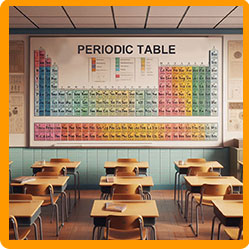
The Periodic Table
The Periodic Table is one of the most important tools in chemistry. It helps us understand how elements behave, how they react, and how they’re related to each other. It’s not just a list of elements — it’s a powerful system built from years of scientific discovery.
Early Periodic Tables
In the early 1800s, scientists began trying to organise elements. They arranged them by atomic mass, but the patterns didn’t always work — elements with similar properties sometimes ended up in different groups. Not all elements had been discovered yet, so the system was incomplete and often confusing.
Dmitri Mendeleev’s Periodic Table
In 1869, Dmitri Mendeleev revolutionised the periodic table. He:
- Arranged elements by atomic mass
- Left gaps for elements that hadn’t been discovered yet
- Swapped some elements to group them by similar chemical properties
Mendeleev’s predictions were later proven correct when new elements were discovered to fill the gaps. His work laid the foundation for the modern periodic table.
The Modern Periodic Table
Today’s periodic table is arranged by atomic number (the number of protons), not atomic mass. This fixes many of the problems in earlier versions. Elements are arranged in rows (periods) and columns (groups) based on their atomic structure and properties.
- Groups: Elements in the same column have the same number of outer electrons and similar chemical properties.
- Periods: Elements in the same row have the same number of electron shells.
Some isotopes are stable, while others are radioactive and used in medical and scientific applications.
Revision Notes

The Cornell method is like a supercharged note-taking system that helps you ace your revision!
Print out our blank revision notes pages to help you revise.
How to make effective revision notes with the Cornell method.
Exam Questions & Answers

Download and print off practice our FREE worksheet with exam style questions on Cell Biology.
Metals and Non-Metals
The periodic table is divided into:
- Metals: Found on the left and centre; they’re typically shiny, good conductors, and form positive ions.
- Non-metals: Found on the right; they’re usually dull, poor conductors, and can form negative ions.
A zig-zag line separates metals from non-metals.
Transition Metals
The transition metals are in the middle of the table (groups 3–12). They are:
- Good conductors
- Strong and dense
- Capable of forming multiple ions
- Often used as catalysts
Examples include iron, copper, and silver.
Group 1 – The Alkali Metals
Group 1 contains the alkali metals (e.g. lithium, sodium, potassium). They:
- Have 1 electron in their outer shell
- Are very reactive, especially with water
- Become more reactive down the group
- Form +1 ions and white compounds that dissolve in water
Group 2 and Group 3
- Group 2 elements are called the alkaline earth metals. They are less reactive than Group 1 but still form basic oxides and +2 ions.
- Group 3 includes elements like aluminium, which is a lightweight metal used in many industries. Group 3 metals form +3 ions and have moderate reactivity.
Group 7 – The Halogens
Group 7 elements are the halogens (e.g. fluorine, chlorine, bromine). They:
- Have 7 electrons in their outer shell
- Are non-metals and form -1 ions
- Become less reactive down the group
- Can displace less reactive halogens in reactions
Group 0 – The Noble Gases
Group 0 elements are the noble gases (e.g. helium, neon, argon). They:
- Have full outer shells, making them very unreactive
- Exist as monatomic gases
- Are used in lighting, balloons, and as protective atmospheres
Also see Atomic Structure, Structure & Bonding, Chemical Changes
Revision Notes

The Cornell method is like a supercharged note-taking system that helps you ace your revision!
Print out our blank revision notes pages to help you revise.
How to make effective revision notes with the Cornell method.
Why Do I Need to Know About the Periodic Table?
In Everyday Life
- Understanding ingredients in products like shampoo, toothpaste, and cleaning sprays
- Knowing which elements are toxic or safe, e.g. why lead is banned in petrol and paint
- Making sense of nutrition labels with elements like iron, calcium, and sodium
- Choosing and using batteries and electronics more responsibly
- Thinking critically about climate change, pollution, and recycling based on element use
- Recognising elements in the news, like lithium in electric vehicles or helium shortages
In Science & Chemistry Careers
- Predicting element properties and chemical reactions using periodic trends
- Extracting and refining metals for use in technology, construction, and transportation
- Designing new materials, medicines, or alloys based on atomic structure
- Understanding how to balance chemical equations and control reactivity
- Using knowledge of groups and periods to develop safer, more effective products
- Working with transition metals and group-specific reactions in labs and industry


